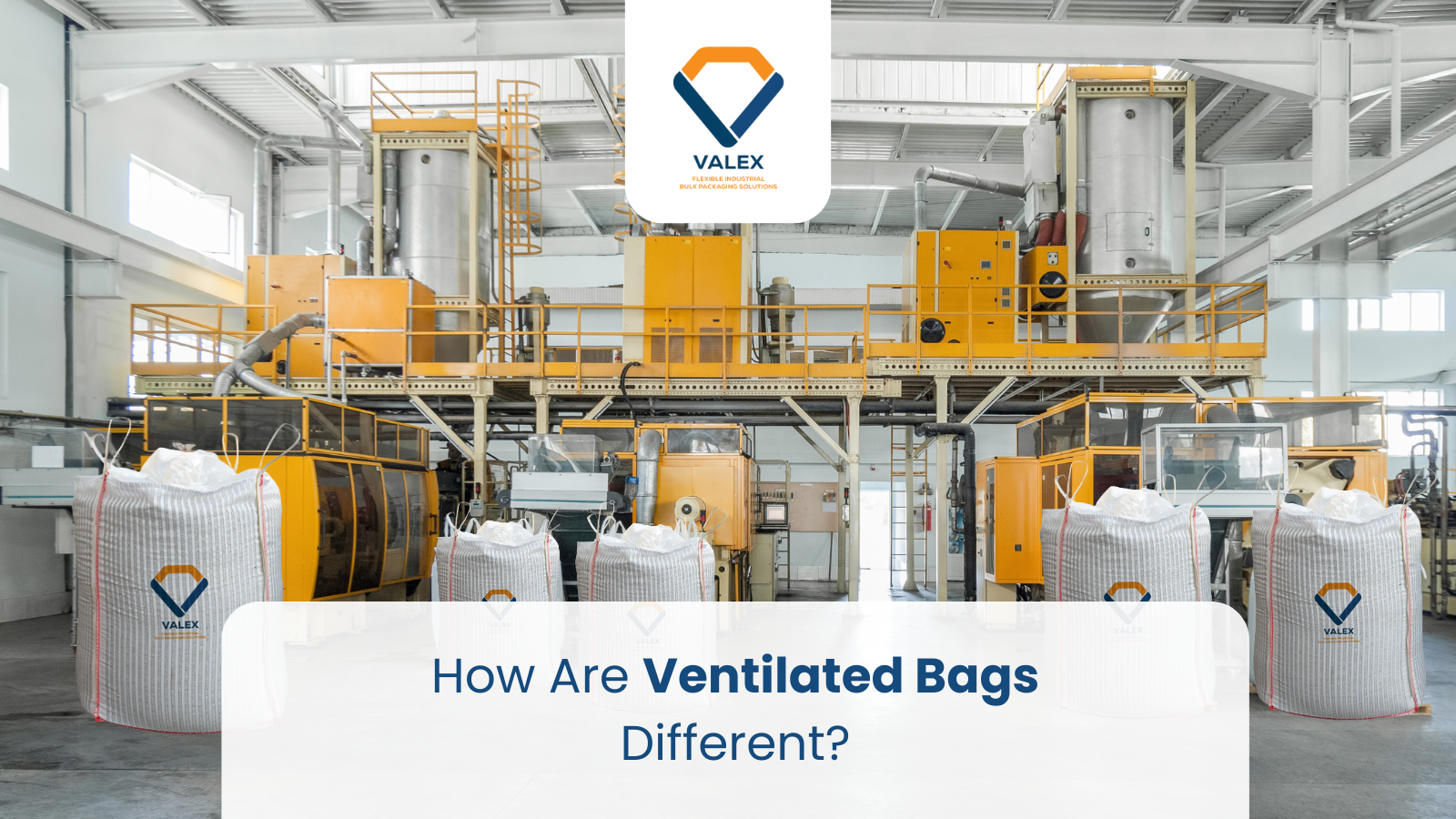A ventilated bag is a type of flexible intermediate bulk container (FIBC) made with special panels or perforations that promote airflow. Unlike solid‑walled bulk bags, ventilated bags allow air to circulate freely through the load, making them ideal for products that must breathe. Whether you call them fibc ventilated bags, vented bags, or ventilated big bags, the principle remains the same: effective moisture and temperature control through built‑in ventilation.
Design and Material: Ventilated big bags incorporate mesh or perforated fabric panels often on all four sides to facilitate air movement. These panels are typically woven polypropylene with calibrated openings that balance airflow with product containment. Standard bulk bags use solid walls that trap moisture and can lead to spoilage.
Airflow and Moisture Control: One of the primary benefits of ventilated bags is their ability to manage humidity. As air passes through the load, excess moisture dissipates, reducing condensation. This makes ventilated bulk bags particularly suited for products prone to mold, mildew, or clumping.
Load Capacity and Strength: Despite their breathable construction, ventilated bulk bags maintain robust load‑bearing capacities. Reinforced seams and high‑strength yarns ensure that ventilated fibc bags can handle weights comparable to non‑vented bulk bags, often up to 2,000 kg, without compromising structural integrity.
Extended Shelf Life: By preventing moisture buildup, ventilated bags help extend the shelf life of perishable and hygroscopic goods. Air circulation keeps contents like granulated sugar, dried vegetables, and seeds dry and free‑flowing.
Reduced Spoilage and Waste: Product loss due to spoilage can represent a significant cost. Choosing ventilated bulk bags minimizes the risk of mold growth and bacterial activity, ensuring higher quality upon delivery.
Energy Efficiency: Traditional drying methods such as forced air dryers consume energy and add complexity. Ventilated fibc bags provide passive ventilation, using natural airflow to control humidity. This reduces energy consumption and lowers operational costs.
Agriculture and Produce: Farmers and distributors often use vented bulk bags for storing onions, potatoes, and other root vegetables. The breathable design prevents heat and moisture buildup, safeguarding freshness from field to market.
Chemicals and Minerals: Certain powdered chemicals and mineral products benefit from ventilation to avoid caking. Ventilated fibc bags make it easier to discharge materials at the point of use, maintaining product flowability.
Industrial Applications: Beyond food and agro products, ventilated big bags find roles in industries such as textiles (storing fibers), pharmaceuticals (bulk excipients), and construction (sand or cement with moisture sensitivity). Their versatility underscores the utilisation of ventilation bulk bags across sectors.

If your supply chain handles moisture sensitive or hygroscopic materials, ventilated bags offer a simple yet effective solution. The benefits of ventilated bags including improved product quality and reduced energy costs make them a smart choice for businesses aiming to optimise storage and transport. Asking why you should buy ventilated bags leads to one clear answer: they combine strength, breathability, and cost effectiveness.
Ventilated bags stand out in the FIBC family by delivering controlled airflow directly through the packaging. Whether you refer to them as ventilated bulk bags, vented bags, or ventilated fibc bags, their purpose remains clear: to protect sensitive products from moisture and heat. By understanding these differences and harnessing the common uses of vented bags, you can handle material processing better, reduce waste, and ensure that your goods arrive in optimal condition.
If your products demand airflow, moisture control, and reliable strength, it's time to upgrade to ventilated FIBC bags. Whether you're in agriculture, chemicals, or industrial supply, these vented bulk bags are designed to protect your materials and improve efficiency across the supply chain.
Reach out to our team today to explore the right ventilated bag solution for your business needs.
Do ventilated bags compromise on strength or durability?
No, ventilated bags are designed to offer the same load-bearing capacity as standard FIBC bags. Their breathable panels are reinforced with high-strength polypropylene, ensuring durability without sacrificing performance.
Which industries commonly use vented bulk bags?
Ventilated bulk bags are widely used in agriculture (for potatoes, onions, and root vegetables), chemicals, construction materials, and textiles anywhere moisture-sensitive goods need airflow during storage or transport.
Can ventilated bags be reused or recycled?
Yes, most ventilated FIBC bags are made from recyclable polypropylene and can be reused multiple times if handled properly. Always check for wear or contamination before reuse.
How do ventilated bags help reduce spoilage?
By allowing natural air circulation, ventilated bags prevent moisture buildup inside the bag. This helps reduce the risk of mold, mildew, and rot, particularly in perishable or hygroscopic products.
Are ventilated big bags suitable for food-grade materials?
Yes, food-grade ventilated FIBC bags are available. These are manufactured in certified clean environments using FDA-approved materials and are ideal for food items that require breathability.
What is the difference between ventilated and non-ventilated FIBC bags?
The key difference lies in airflow. Ventilated FIBC bags feature mesh or perforated panels that allow air movement, making them ideal for moisture-sensitive goods. Non-ventilated bags have solid walls and are better for dry, flowable products that don't require ventilation.